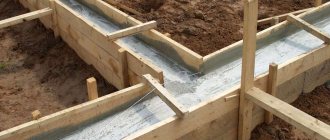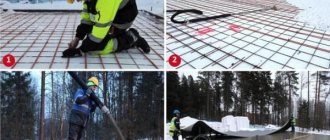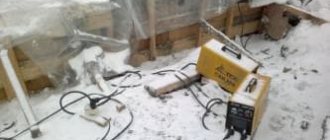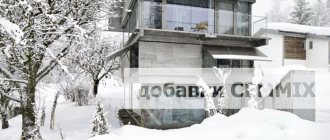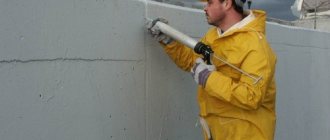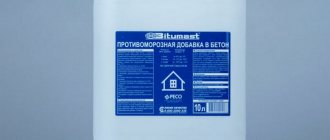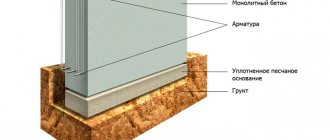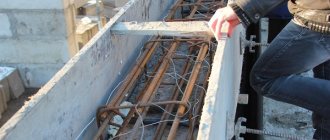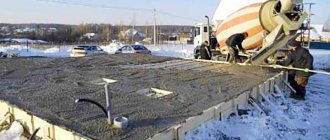When starting the construction of monolithic concrete structures, you should familiarize yourself with all the rules for caring for them in advance. They are necessary for the concrete to gain its original strength and serve for many years. Otherwise, cracks will begin to appear on its surface, which will lead to shrinkage of the building and loss of its functionality. SNIP provides for concrete maintenance at any time of the year, but if you can choose a construction season, it is better to choose the summer option.
At this time of year, it is necessary to provide the concrete with optimal hydration conditions in order to achieve maximum structural strength. All protective measures take place in two stages.
Concrete maintenance - factors affecting the strength of concrete. Features of care in summer and winter
As you know, concrete is one of the strongest and most durable materials, which explains its wide popularity both in the field of industrial construction and among individual developers. And if professional specialists know all the features of the technology, then mistakes are often made during the construction of private houses. People do not know that caring for concrete after pouring in late autumn differs from similar events in the summer and, especially, winter, and in this review we will look at how to properly care for the material.
After completion of concrete work, a whole range of special measures will be required to ensure high strength of the material.
How the surface is wetted in the summer
Concreting a foundation is a complex and labor-intensive process that involves wetting the surface. How to care for concrete on hot days? Experts recommend taking into account the following nuances:
- The cement mortar should be poured early in the morning or after sunset. In the summer, it is necessary to take care of protecting the freshly laid mixture - cover the surface with slate, corrugated sheets, roofing felt or other material.
- The next point is that not only hot weather, but also the heat generated during the hardening processes contribute to the rapid evaporation of moisture. Therefore, on the first day and the next 2, the base should be constantly moistened with water. This should be done every 2-3 hours, especially in windy, sunny weather.
- Watering of the product is carried out 3 times a day for 28 days.
Wetting of concrete is carried out in a diffuse manner, in the form of raindrops. In case of water interruptions, another wetting should be done - treat the freshly poured mass with a film-forming agent with good adhesion.
What you need to know about concrete
To understand how important it is to care for freshly poured concrete structures, let’s get acquainted with the main features of the hardening of this material:
- The strength of the material is due to a rather complex chemical process called hydration . The bottom line is that water molecules gradually penetrate into the cement particles, as a result of which new super-strong compounds are formed.
The photo shows cement, which, when combined with water, forms a very strong and durable connection.
- The hydration process is quite long, which determines the long period of concrete gaining strength characteristics . Water penetrates the cement gradually and reaches the center of the cement particles only after several months.
- Despite the fact that the development of strength takes a long time, the structures can be used after 28 days, when the material becomes sufficiently reliable and resistant to deformation.
- During the curing process, the volume of the composition decreases, that is, it shrinks . This is normal, moreover, by monitoring shrinkage rates, you can roughly calculate the strength of concrete, although this method is most often used by professionals, since a simple developer is unlikely to have special equipment - its price is quite high.
- It is known that concrete structures that dry in a humid environment gain much higher strength than in the open air . This property is very important to always remember, because there is nothing worse than drying out the surface.
Rules for caring for monolithic structures
Large surfaces lose moisture much faster, so they should be moistened more often. To ensure sufficient watering, you can build a continuous irrigation system, it is important to use galvanized pipes for this. The fact is that tap water contains a lot of iron, which will settle on the surface of the concrete, and galvanized pipes will prevent this. If the structure is being erected using concrete blocks, then each of them must be watered from all sides and must be covered with film or a protective compound.
Factors affecting the strength of concrete
In fact, the rate of strength gain and final characteristics depend on several important nuances:
- Cement, which is used to prepare concrete. Its different types have different periods of gaining primary strength; it is worth using Portland cement. It is best suited for use due to its excellent characteristics and the shortest curing period.
- Humidity, the reliability of the structure directly depends on this indicator. Its ideal indicator for a set of high properties is 90 percent. It needs to be maintained constantly; the easiest way to do this is with a sprayer.
Caring for freshly laid concrete primarily involves constantly moistening the surface and preventing it from drying out.
- Air temperature: the best conditions for achieving optimal properties of the solution are created at +20 degrees. At zero temperature, the solidification process stops, and at negative values, the water in the structure freezes and, expanding, damages the material, reducing its strength.
Features of care depending on external conditions
As noted above, the activities carried out as part of the maintenance of concrete primarily depend on temperature and humidity. If these indicators are optimal, then this greatly simplifies the work, but in practice ideal conditions practically never occur and, nevertheless, you can create them yourself. Let's consider the main options for work depending on environmental conditions (read also the article “Concrete balusters - a simple way to refine a staircase”).
Summer period
Anyone can make a reliable foundation with their own hands, but any violations of technology can reduce the strength
Most often, work is carried out in the summer, since this is the most favorable period in the sense that temperature changes are insignificant and the working conditions are quite comfortable.
But high temperatures also create a lot of difficulties, because drying out the surface is contraindicated for a number of reasons:
- Termination of the hydration process in the surface layer, due to which its strength is significantly reduced.
- Also, due to too rapid evaporation of moisture, surface cracks form, which over time can cause more significant damage.
This is what happens when a concrete base quickly loses moisture
- Drying can cause a decrease in strength, and this figure can be even 40%, that is, the final reliability of concrete will be only 60% of what was planned.
- When dried prematurely, the surface structure becomes more porous, which reduces its moisture resistance and frost resistance. In addition, deformation resistance decreases.
How to protect concrete and create the most favorable conditions for its maturation? All measures are quite simple, but they must be followed carefully.
The simplified instructions look something like this:
- In sunny weather, it is very important to protect the freshly poured structure from exposure to the sun and wind. For this purpose, any shields or canopies from awnings can be used. At temperatures above 25 degrees, it is better to use reflective film, although this is not necessary for small objects.
Advice! Among private developers, when pouring strip foundations and small screeds, the simplest option is polyethylene film; it will protect the surface from moisture evaporation and weathering.
Regular transparent film is ideal when working indoors
- The first moistening is carried out after a few hours, it is very easy to find out that this is necessary: the surface will become much drier, but it is important that it does not dry out, this can have irreversible consequences for the final result.
- The frequency of moistening is 2-3 hours during the day; at night, a single treatment can be carried out - the temperature during this period is lower, and this is usually sufficient.
- Moistening is carried out in this way for the first few days, then this process is carried out as necessary, but the condition of the concrete must be constantly monitored.
Important! If the surfaces are open and there is no way to protect them, then they should be coated with either bitumen emulsion or Etinol varnish, this will prevent moisture loss.
Preliminary stage of care
Activities for the care of concrete mortar practically begin immediately after it is poured and the surface is finished. Work continues throughout the entire period of strengthening of the material.
Since according to the project this period is 28 days, the care of concrete during the hardening process should take place during this time. First, it is necessary to provide the fresh solution with reliable protection from natural phenomena. As a rule, the main stage of the measures involves the use of film-forming materials.
In some cases, it is necessary to carry out a preliminary stage, which is performed using damp burlap, sealed films and other materials. The preliminary stage is carried out in cases where:
- the air temperature is above 25° C and the weather is dry, hot;
- the use of film-forming material is impossible in the near future;
- the main stage does not imply the use of protective materials or air temperatures below +5° C;
- it is raining or snowing.
After completing the preliminary stage, they immediately move on to the main measures to protect the concrete.
Summer protection measures
It is especially important when caring for concrete in the summer to protect it from sunlight in order to stop excessive evaporation of moisture. During the first week after pouring, the solution should gain about 55-60% strength. If you do not provide the necessary humidity during this period, cracks will appear on the top layer of the solution and the material will lose its strength.
In the future, it is possible that the hardening process will slow down or completely stop. Therefore, one of the main tasks is to provide the solution with a favorable temperature and sufficient moisture. Based on the brand of cement and climatic conditions, they plan a maintenance method.
At the same time, it is taken into account that with uneven heating, large cracks may appear in different parts of a huge monolithic object. This happens because during hardening the volume of the structure will change unevenly. Therefore, it is necessary to moisturize those parts of the structure that are exposed to direct sunlight. Methods for maintaining humidity include:
- Application of a special protective composition to the surface of the concrete mixture.
- Spilling the surface of the mortar and formwork with water using a covering material.
- Protecting the surface from sun and wind.
When watering, it is not recommended to allow the surface to dry out, that is, it should always be kept moist.
Heat control of massive concrete structures
If the structure is massive, for example, a monolithic foundation slab or a monolithic floor, it is necessary to provide for a gradual rise in temperature in the concrete mixture during its hardening.
During hardening, that is, during hydration of cement, heat is released, since setting and hardening of cement are exothermic processes. Due to the fact that the thermal conductivity of concrete is relatively low, hydration inside massive concrete structures leads to a significant rise in temperature.
The main mass of heat is released during the first 3-7 days of cement hardening.
Within 7 days from the moment the cement is mixed with water, 1 kg of grade 300 cement releases more than 30 Kcal of heat in concrete, and grade 500 cement releases more than 50 Kcal.
In massive structures, this heat has nowhere to go. The entire structure heats up, especially at depth, in the middle, and even reaches the top of the surface. The temperature can reach quite high values: 50 - 70°C, sometimes 80°C, and can decrease within several months if no action is taken.
Why is it necessary to take measures to ensure that the temperature does not exceed certain values? First of all, this is necessary in order to prevent a temperature gradient between the middle layer and the surface.
Temperature gradient : When the temperature of different parts of the body varies, spontaneous heat transfer occurs from areas of higher temperature to areas of lower temperature. The occurrence of the process is caused by a property called thermal conductivity.
If this gradient exceeds 20-30°C, then a rupture of the concrete structure may occur, the appearance of not only internal cracks, which can subsequently heal, but also external cracks. That is, intense cracking will occur, which is not acceptable for any structures.
In addition, an increase in the temperature of freshly placed concrete leads to faster hydration of the cement, and, consequently, to accelerated setting and lower strength of the hardened concrete.
How do such structures achieve temperature reduction?
When concreting in hot weather, some measures can be applied during the concrete production process to reduce its temperature. So, in order to reduce the heat of hydration, it is necessary to reduce the cement content in the concrete mixture to a minimum. You can also use ice instead of some water for kneading. However, it is necessary to ensure that the ice has completely melted before the end of mixing the concrete mixture.
Methods for caring for concrete on site
First of all, after covering the surface with a vapor-proof material, cold water is poured onto this surface. Either pour sawdust and pour water over it, or pour in cold water and, after heating it, change it back to cold.
It is equally important to prevent a sharp decrease in the temperature of the concrete. The difference in temperature between the surface and the middle layer should not exceed 20-30°C , depending on the massiveness of the structure. The main thing is to ensure the rate of temperature rise and the rate of temperature decrease.
The rate of temperature decrease should not be sharp. It is usually 1-2°C per hour, and for some it is 12-13°C per day. This is indicated in the technological regulations depending on the massiveness of the structure, the materials used, etc.
Various methods are used to ensure a slow decrease in temperature. If suddenly the temperature drops too quickly (usually this happens when the air temperature has dropped sharply and the surface cools down very quickly and the difference between the temperature on the surface and the temperature inside the structure is very large, which should not be allowed), then thermal insulation materials must be laid on the surface of the concrete structure materials.
Most often these are rolled thermal insulation materials, for example, mineral wool boards. This allows you to retain heat on the surface of the structure, and then the difference between the temperatures of the outer layer and the inner layer will tend to be minimal. If one layer of thermal insulation is missing, add the next layer.
Caring for concrete involves knowing the temperature. How to find out the temperature of concrete? It is necessary to provide for temperature measurement during the hardening of concrete in the structure.
To measure the temperature of concrete, various devices are used: technical thermometers, thermocouples, electronic devices. The temperature on the first day after pouring the concrete mixture is measured every hour, but not less than every two hours. The next day, measurements are made once every 8 hours. These temperatures are necessarily recorded, and as soon as they go beyond the permissible limits, measures are taken to bring down this temperature.
In order to measure the temperature inside the structure during concreting, special hole-formers (polymer tubes) are inserted into which a thermometer and thermocouples can then be lowered.
The forming hole is a polymer tube into which a thermometer can be lowered to measure the temperature of concrete
Typically, temperature measurements are made in several places of the structure, but not less than 8 meters of the surface. That is, every 8 meters of the structure must have holes for measuring temperature.
If we talk about the winter time of concreting, then the main task there is to ensure the hardening of concrete until it acquires critical strength. This is the strength at which the influence of low temperatures will not be negative. As a rule, critical strength is achieved within 3-7 days. During this period, it is necessary to provide the concrete with the conditions under which it hardens, that is, to provide the required hardening temperature. And this temperature is not lower than +5°C.
When the outside air temperature is below zero, the structure needs to be heated. In some cases, they do without heating, using the internal heat of cement hydration. And here the conditions for summer and winter differ. In summer, the hydration process is dangerous for concrete, and in winter it plays into the hands of builders, since internal heat can be preserved by using thermoosmas (like a thermos). Thanks to this, the structure is heated.
Concrete work at high temperatures
On hot summer days, caring for concrete after pouring is especially important. SNiP (Building Norms and Rules) recommends during this period to lay concrete prepared with quick-hardening grades of cement. They begin to use it at temperatures above 25° C, while the value of the solution itself should not exceed 30-35° C.
Therefore, it is important to maintain the temperature of fresh concrete to 25° C. If cracks appear, the solution can be vibrated again, but no later than an hour after it is laid. After this, the concrete surface is covered with waterproofing material, which must be periodically moistened.
It is not allowed to pour water on open areas of a concrete structure, as sudden temperature changes will lead to destruction of the material. In this case, watering must be carried out only by spraying in order to prevent damage to the integrity of the top layer.
Warming up concrete in winter
The main feature of caring for fresh concrete in winter is its heating. If this measure is not carried out, then as a result of the freezing of water in the solution and the expansion of ice crystals, pores are formed in the material, which reduce the strength of the structure. Today there are many heating methods:
- One of the oldest methods is the thermos method, which is based on the hydration effect. The well-heated solution is delivered to the site at the asphalt concrete plant, very quickly placed in formwork and covered with heat-insulating material. When water interacts with cement, heat will begin to be released. As a result of this process, by the time it freezes, the concrete will have time to gain critical strength.
- The use of antifreeze additives, subject to technology and certain rules, also makes it possible to ensure concrete strength gains. In this case, the formwork must be covered with waterproofing material to prevent precipitation from entering the concrete mixture.
- A particularly popular method of caring for the solution in winter is electric heating. It is usually carried out using electrodes of different shapes. After laying the concrete, electrical conductors are buried into it at a certain distance; usually, reinforcement pins are used. Then a connection is made through one or two electrodes using wires coming from a special step-down transformer. When the heating process begins, the electric current between the electrodes will pass through the liquid solution, which will begin to heat up and solidify. This method is also very often used using a reinforced formwork frame.
Why water concrete?
During the hardening process of concrete, special attention should be paid to moistening the composition. Why do you need to water concrete? There are a number of factors that prove this need.
- Water is the main element of cement mortar. It participates in physical and chemical processes, as a result of which it is quickly neutralized. For optimal hardening of the concrete mixture, a certain amount of moisture is required, which must be compensated.
- The hardening of cement occurs heterogeneously. The upper layers are characterized by weak exchange processes and, as a result, the unstable hardened surface quickly deforms when the concrete layer inside is still liquid. In order for the structure to gain strength, it is necessary to ensure optimally identical conditions.
- During hardening, the base decreases in volume. You can make up for losses using a dosed amount of liquid.
- Climatic conditions are a factor that has a direct impact on the formation of a durable structure. Hot air promotes rapid evaporation of water, so the foundation needs constant watering. Windy weather leads to the removal of moisture particles from the cement, which provokes the appearance of numerous cracks in the surface.
Microcracks are one of the risks when forming a foundation. Through them, rainwater, dirt and dust enter the product. As a result, the surface remains intact, but the internal part of the structure is deformed. The formation of cracks and cracks in the foundation occurs in winter with strong temperature changes. When moisture gets inside, it turns into ice, which has the properties to expand and increase the size of the crack. Swelling of the base occurs, and after the foundation, destruction proceeds to the main structure. Water is involved in hydration processes. The optimal level of moisture contributes to the development of strength characteristics.
Rules of care
In order for the structure to meet all requirements, it is necessary to properly prepare the concrete mixture. It is not recommended to store building material for a long time even in a special mixer. The mixture should be used immediately after mixing. The average daily air temperature at which the solution will harden well should not be lower than +5°C.
To prevent the concrete structure from being washed away by groundwater (if the product is made on the ground, such as a foundation), waterproofing should be installed. Otherwise, the hardening process may be disrupted.
Concrete care begins immediately after pouring. It is necessary to inspect the structure for leaks, unevenness and other defects that may cause a deformed product.
The material must gradually increase its strength. For this process to proceed correctly, it is necessary to create optimal humidity and thermal conditions. After pouring, it is recommended to cover the mixture with plastic wrap. It will prevent the solution from drying out prematurely. If the structure quickly loses moisture, for example, after 60-90 minutes, the formwork should be checked for integrity.
The plastic film will allow the concrete mixture to harden evenly. If you do not use it, the top layer of the structure will dry out faster and will put pressure on the fragile base.
To prevent cracks from forming on the surface, which will deepen over time, the concrete should be moistened. 8-10 hours after pouring, you need to water the foundation. You can use tap water and a hose to do this.
To water steeply sloped surfaces or vertical structures, use a pipe system with small holes. Through them, continuous irrigation of the product must be carried out. Another way is to cover the concrete with sawdust or burlap. If these materials are wet, they will retain moisture for a long time and reduce the percentage of evaporation.
Concrete reaches its maximum strength after a month, but its physical properties are influenced by the first 3 days. It is recommended to start stripping no earlier than after 3-4 days. There are differences between how to care for concrete in summer and winter.
Mixture composition
- cement (after mixing, it connects the elements of concrete);
- water;
- aggregate (sand, crushed stone or gravel).
It is possible to improve the operational and technical performance of a structure with the help of special additives (mineral or organic).
Beginners do not always understand for what purpose it is necessary to water concrete after pouring, because they do not know the features of this material. The main active components are water and binder, which envelop the aggregate (which is passive in the mixture).
Water plays an important role in cement mortar. It takes part in physical and chemical processes that lead to its neutralization. Gradually, moisture evaporates and the binder hardens. As a result of binding aggregate grains, concrete (durable artificial stone) is obtained from the mixture.
Fillers occupy up to 85% of the total volume. Their properties influence the physical and mechanical properties of concrete. The share of water in the mixture is about 7% of the volume, cement - 13%.
The top layer loses moisture faster (compared to the bottom layer and middle), so cracks may appear in the concrete. When the surface overdries, the strength of the product decreases and the design will not be able to meet the required grade.
Summer care
Concrete maintenance in summer is carried out in accordance with weather conditions. It is not recommended to work in hot weather. The solution should be poured in the morning or evening - after the activity of sunlight has decreased and the ambient temperature has dropped. If it is not possible to carry out construction work at a suitable time, plastic film, roofing felt or slate will help protect concrete from the sun.
On a rainy day, care must be taken not to leave precipitation on the surface of the holes. Washing out the mixture with rainwater before the setting process can lead to a decrease in the strength of the product (the percentage ratio of the components of the solution is violated). For this reason, it is not recommended to carry out concreting if it is not possible to protect the structure from precipitation.
If the sun's activity is moderate and there is no strong wind, the structure can be irrigated every 10 hours. If the surface dries quickly, reduce the time between waterings. In order not to disturb the hardening process, it is recommended to irrigate the structure at night.
When pouring a foundation or other object with cement mortar, plasticizers can be used. These are substances that help maintain the required moisture concentration in the mixture. Therefore, in order to maintain concrete in the summer without problems, plasticizers should be added. They also improve other structural strength characteristics.
Need for hydration
Often, those new to construction pour concrete into the foundation with their own hands and are sure that the work ends there. However, it takes time (up to 4 weeks) for concrete to gain the required strength.
Strength is influenced by ambient temperature and precipitation. Only after this period has expired is it possible to begin building walls (if we are talking about building a house).
If the ambient temperature is high and a strong wind is blowing, the process of evaporation of water from the outer layer will occur more intensely. And due to rapid drying, depending on its speed, precipitation will occur faster. This causes areas with numerous small cracks to appear on the surface of the structure.
When the hardening process is completed, under the influence of negative environmental conditions, cracks will contribute to the destruction of the concrete structure. In winter, water that gets into cracks freezes and can tear the structure apart.
When the foundation of a building is subjected to such destruction, cracks may appear on the facade, and their size will gradually increase. If the top layer is overdried, the process of cement hydration stops. Because of this, strength is gained slowly and is lower than the planned grade.
Winter care
All construction and repair work that involves the use of concrete mixture is not recommended to be carried out in cold weather, i.e. in winter. Construction in the cold season will require additional financial costs.
If the air temperature drops below 0°C for a short period of time and then rises above +5°C, frost is not critical. In order for the structure to harden properly, special anti-frost modifiers are added to the solution. They prevent the mixture from freezing. If they are not used, it is recommended to heat the solution before pouring and wrap it.
At large construction sites, special heaters can be used in winter. At home, their use will be expensive. Caring for concrete in winter means keeping it warm. Heating is necessary in order to retain the thermal energy of hydration in the solution.
Components of standard concrete
Concrete dough is relevant for the construction of strip, monolithic or columnar foundations.
Components of cement mortar
A typical concrete mass consists of the following raw materials:
- cement - has astringent properties that ensure the combination of ingredients into a single solution. To prepare a high-quality mass, you will need material marked M500;
- sand is one of the fillers of the mixture. Only bulk raw materials with uniform fractions from 1.5 to 5 mm are used. Foreign impurities are sifted through a fine sieve. To make the composition durable, use river sand;
- crushed stone is the main filler. In home construction conditions, crushed stone or gravel materials with fractions of 8 – 35 mm are purchased. To ensure a tight fit of the particles, small and large raw materials are mixed.
To prevent debris from getting into the mixture, the components are poured out on a clean tarpaulin. The binding element of the solution is water. The liquid is filtered before adding to the remaining ingredients.
Do I need to add plasticizers?
- ready-made slaked lime, which ensures the strength of the composition;
- plasticizers that impart fluidity or viscosity to the solution;
- reinforcing components - needed to strengthen the foundation in conditions of soil instability.
Before purchasing, it is important to study the technical characteristics and technology of using auxiliary components.
Solution calculation technology
At home, it is advisable to prepare the concrete composition manually. You will need 1 part cement mixture, 2 parts sand, 3 parts gravel, additives and water. Take into account the difference in the volumetric mass of the material and carry out the calculation in buckets: a bucket of sand will weigh 19 kg, cement - 15 kg, and crushed stone - 17.5 kg. Water is added to the ingredients and the solution is mixed until smooth. After pouring the foundation, what follows is a technologically complex physical and chemical reaction - the release of heat and evaporation of water, as a result of which an artificial stone is formed.
Caring for concrete in winter according to current codes of practice
After preparing the base and laying the concrete mixture in winter conditions, it is necessary to properly maintain and maintain the concrete mixture in accordance with clause 5.1.7 - clause 5.1.17 of the current SP 70.13330.2012 Load-bearing and enclosing structures. Updated version of SNiP 3.03.01-87
Let us recall that winter concreting conditions occur when outside air temperature is below 5 °C and the minimum daily temperature is below 0 °C ( according to clause 5.11.1).
5.11.7 Temperature and humidity curing of concrete in winter conditions is carried out:
- thermos method;
- using antifreeze additives;
- with electrical heat treatment of concrete;
- with heating of concrete with hot air, in greenhouses.
Curing of concrete is carried out according to specially developed technological maps in the PPR, which must contain:
- method and temperature and humidity conditions for curing concrete;
- data on the formwork material taking into account the required thermal insulation indicators;
- data on vapor barrier and thermal insulation covering of open surfaces;
- diagram of the placement of points at which the concrete temperature should be measured and the name of the devices for measuring them;
- standardized strength values of concrete;
- timing and procedure for stripping and loading structures.
In the case of using electrical heat treatment of concrete, the technological maps additionally indicate:
- diagrams of placement and connection of electrodes or electric heaters;
- required electrical power, voltage, current;
- type of step-down transformer, cross-section and length of wires.
The choice of method for carrying out concrete and reinforced concrete work in winter conditions should be made taking into account the recommendations given in Appendix P.
The tables in this appendix are given below (it should be noted that appendix P is advisory in nature):
Table A.1 - Selection of the most economical concrete curing method for winter concreting of monolithic structures
Table A.2 - Methods for heating concrete in monolithic structures during winter concreting and rational areas of their application
Proper care in winter
Many experts do not recommend concreting the foundation in the cold season. But if you had to do this, then get ready for additional financial investments. How long does it take to maintain concrete in winter? When the mixture hardens at low temperatures, it heats up internally and cools quickly outside. The difference provokes the appearance of cracks on the surface of the product. Additional insulation of the fill may be required in various ways to block the weathering of moisture. Recommendations for building a foundation in the cold season are as follows:
- Add special additives to the cement mortar that prevent the mixture from freezing.
- During pouring, the solution can be heated with electricity. Electric heating is carried out by electrodes. The principle is based on the physical properties of current, which, passing through a material, releases a certain amount of heat. The conductor is concrete.
- When pouring the base, the formwork is insulated with polystyrene foam, sawdust, hay or cotton wool.
- The optimal temperature for pouring mortar in winter varies from -3°C to +3°C.
Proper insulation of the concrete mass and subsequent care protects against premature drying out, chemical and mechanical damage, protects against temperature changes and the formation of cracks. When the air temperature is below +5, watering the foundation should not be carried out.
To get a reliable design, experienced builders recommend the following:
- Upon completion of pouring the cement mortar, it is necessary to recheck the condition of the formwork. If there are defects, they can be eliminated within 2 hours before the hardening process begins;
- during hardening, the structure is protected from mechanical damage, pressure and sunlight;
- cracks that appear in plastic concrete can be eliminated by vibration;
- The surface should not be filled with water, but moistened in doses.
By following these tips, you can get a quality foundation for your home.
A homeowner who makes his own foundation must take into account all the nuances of its installation and maintenance at certain times of the year. Only by following clear recommendations can you make a high-quality base for the structure.
Proper care of concrete is aimed at achieving several goals at once:
- protection from temperature changes;
- protection from premature drying;
- protection from mechanical and chemical damage;
- minimizing plastic shrinkage of the concrete mixture;
- ensuring strength and durability.
Care process
In accordance with regulatory documents (clause 2.66 of SNiP 3.03.01-87), concrete care begins immediately after the completion of its laying and is carried out until the concrete mixture reaches 70% of its brand strength.
Sequence of concrete care:
- After laying the concrete mixture, we inspect it: see if there are any leaks or breakdowns. To eliminate defects, you have 1-2 hours from the moment of laying - until the concrete begins to set;
- at the hardening stage, we protect concrete from mechanical influences: shocks, impacts, etc.;
- Once installation is complete, cover the concrete. Plastic film, burlap, and tarpaulin are suitable;
- for concrete hardening, 90-100% is needed, which will significantly increase its strength. In the event of unplanned dehydration (for example, leakage of cement laitance due to poor formwork), the strength of the concrete surface decreases, peeling from the concrete, increased water absorption, and the appearance of early and then late shrinkage cracks are possible. Shrinkage cracks appear as a result of a significant reduction in the volume of freshly laid concrete on the surface, then the cracks can penetrate deeper. It is important that concrete drying begins after the concrete stone has gained sufficient strength and can withstand shrinkage stress without cracking;
- if early cracks are detected at a stage when the concrete mixture is still plastic, we eliminate them using vibration;
- after approximately 8 hours of hardening, the concrete gains a strength of 1.5 MPa and must begin to be moistened with diffuse watering on a regular basis, for example: cover the surface of the concrete with sawdust, burlap or tarpaulin; moisten them with water; cover with plastic wrap. If the average daily temperature is below +5°C, then the concrete is not moistened;
- if it occurs, we cover the concrete with heat-insulating materials: polystyrene foam, mineral wool, hay, sawdust, rags, etc.;
- if regular moistening is impossible, then we cover the concrete with polyethylene with a thickness of at least 0.2 mm, while laying the panels overlapping with an overlap of 30 cm, taping the seams.
How long does it take to maintain concrete?
Concrete maintenance can be completed after it has gained at least 70% strength. To determine the timing, you can use data on concrete’s gain of compressive strength under conditions of different hardening temperatures:
The deadline for finishing concrete care is .
Caring for concrete in the summer is a mandatory activity, on which the quality of concrete depends. They begin as soon as the concrete is laid and compacted and continue for a certain period of time.
The purpose of these rules is to create favorable conditions for hydration. As a result, concrete gains strength characteristics when liquid and plastic glue transforms into a stone state.
How to care for concrete after pouring at different times of the year?
Water is an important component of the concrete mixture, which participates in the chemical reaction when the screed hardens. Therefore, caring for concrete after pouring is aimed at retaining moisture or constantly moistening the surface. The external environment determines the methods for maintaining the hardening process of the material. Therefore, it is not necessary to care for concrete after pouring in the same way in winter and summer. This takes into account the temperature and degree of air humidification.
Stages of concrete protection
- Initially, an analysis of the environmental impact on the concrete pavement should be carried out. It is its insufficient resistance to this that affects the subsequent strength of the entire structure. After the design is completed, the first stage begins. It includes the preparation of the optimal composition of the concrete mixture, which will withstand external influences. To do this, various impurities are added to improve density, frost resistance, crack resistance and water resistance.
- The second stage is to protect the already laid coating. To do this, it is necessary to cover the surface of the concrete with a special coating that will prevent or limit its contact with the environment. This is done to control the moisture content of the concrete mixture and protect it from destruction. It is also important to maintain an optimal temperature on its surface, which does not always coincide with natural temperature. Therefore, shelter is required.
How does the external environment affect concrete?
Experts have established the optimal air temperature for pouring the material - 20 °C.
The process of gaining strength in a concrete coating occurs as a result of the gradual penetration of water into cement grains. This process is called hydration. Violation of technology occurs due to excessive evaporation of moisture or freezing of the liquid included in the solution. Hydration is impaired due to the influence of such factors:
- Wind. Rapid air movement leads to accelerated loss of moisture from the concrete coating. This stops the hydration process and reduces the quality of the structure.
- Sun. Heat and ultraviolet radiation cause the screed to dry out, causing the top layer to crack.
- Low temperatures. Freezing of water in a concrete solution leads to its expansion and destruction of the formed hydrates. Therefore, this design loses strength and is considered unsuitable for further use.
Additional protections
To increase the strength of the concrete coating, various protective mixtures are sprayed onto its surface. They are white, black and colorless.
Black protects well from wind and direct sun, but its surface, on the contrary, increases heat absorption and overheats the concrete. Black bituminous mastic acts even worse; it evaporates a large amount of moisture during the wind. White additives, due to their color, reduce heat absorption, while colorless additives do not affect the appearance of concrete. Modern technologies have made it possible to obtain a product that creates a transparent film on the surface. This type of coating can be found on the floors of large hypermarkets. It involves improving the durability of concrete at average temperatures and humidity. But even when using such additives, one should not forget about the need to regularly moisten the coating.
General recommendations
Based on the factors that determine the strength of a concrete structure, we can conclude that caring for concrete is to reduce the negative impact of the external environment. Measures to protect the coating at different times of the year differ, so concrete laying must be carried out with the least risk of hydration problems. Reducing moisture evaporation is achieved by covering the surface with film protection or bitumen paint. Freezing can be prevented by insulating the formwork or adding special antifreeze mixtures.
Nuances of care
In summer time
Most often, concrete is poured at this time of year, as this is due to comfortable working conditions and the vacation period that falls during this period. Caring for concrete in summer differs from winter installation. You can save on formwork insulation. To prevent excessive drying of the concrete surface, the following means are used:
- Film coatings. Prevents moisture evaporation. The protective material is laid after the mixture has hardened.
- Reflective films. Used when exposed to direct sunlight and high temperatures.
- Film-forming composites. The most commonly used is bitumen emulsion or Etinol varnish.
Using a hose with a sprayer is recommended to wet the concrete on the day of pouring.
In addition to protective work, the surface is additionally moistened by spraying ordinary water. This process is carried out within 2-3 hours after pouring. In hot weather, re-irrigation is necessary when the surface dries out. This period can be from 2 to 4 hours. A single event may be held at night. Such procedures are carried out for 2-3 days, after which the degree of moisturizing is controlled for 1-2 weeks, and if necessary, moisturized again.
According to SNiP 3.03.01-87, the concrete coating immediately after pouring must be protected from evaporation and the effects of precipitation, and mechanical impacts on the coating are allowed only after reaching a strength of at least 2.5 MPa.
Features of work in the winter season
At a temperature of 0 °C, the hydration process stops completely, and negative thermometer values lead to the destruction of already formed crystals, which give the structure strength. Therefore, caring for concrete in winter is aimed at reducing the influence of the temperature factor. To do this, insulated formwork is constructed or chemical components are added to the finished concrete solution to prevent water from freezing. Another method of insulation is the use of electric heaters, but this is not economically viable. Therefore, before laying concrete, it is necessary to foresee all the costs directly for caring for the structure and select the optimal time for pouring it.
